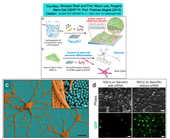Highlight
NANORU: Nanotechnology for Stem Cell Reprogramming
Achievement/Results
NANORU: Novel Nanodevice for Genetic Reprogramming of Stem Cells: An IGERT fellow and his lab colleagues have developed a novel nanoscale approach to genetically engineer stem cells. Gene expression levels encoding key lineage specific protein factors in stem cells can be manipulated at the level of RNA interference (RNAi). However, the conventional methods used to deliver small interfering (siRNA) into stem cells result in significant cytotoxicity and undesirable side-effects. To this end, we have developed a nanotopography-mediated reverse uptake (NanoRU) delivery platform to demonstrate a simple and efficient technique for delivering siRNA into neural stem cells (NSCs).
NanoRU consists of a self-assembled silica nanoparticle monolayer coated with extracellular matrix proteins and the desired siRNA. We use this technique to efficiently deliver siRNA against the transcription factor SOX9, which acts as a switch between neuronal and glial fate of NSCs. The knockdown of SOX9 enhanced the neuronal differentiation and decreased the glial differentiation of the NSCs. Our NanoRU platform demonstrates a novel application and the importance of nanotopography-mediated siRNA delivery into stem cells as an effective method for genetic manipulation.In recent years, RNA interference (RNAi) has become a major area of interest for directing stem cell fate. This methodology involves using small interfering RNA (siRNA) to selectively silence (or knockdown) genes or pathways to control stem cell differentiation.
A major challenge to reprogramming the behaviors of stem cell lineages is efficient delivery of the genetic material (like siRNA) into stem cells. The most common methods include solution-based delivery using viruses, non-viral cationic lipids, nanoparticles and polyplexes. However, when treated with exogenous materials, stem cells tend to die or undergo undesired differentiation patterns. Therefore, there are concerns associated with the introduction of viruses, nanoparticles, and other exogenous materials into stem cells. From the vast repertoire of techniques that can be used to deliver siRNA into stem cells, methods based on substrate-mediated delivery, where cells uptake siRNA from their microenvironments, are extremely advantageous as they provide a way to “locally” improve the efficacy of siRNA delivery by simply changing the cellular microenvironments. However, the fact that nanotopographical features of the extracellular microenvironment can be used to deliver siRNA into stem cells efficiently remained to be explored.
Trainee Shreyas Shah of the Rutgers NSF funded IGERT Program on Integrated Science and Engineering of Stem Cells has pioneered an extracellular matrix (ECM)-based nanotechnology platform in the laboratory of Professor KiBum Lee to successfully control gene expression. Together with lab member S. Solanki, they have developed a simple technique to deliver siRNA into NSCs using nanoparticle films coated with a mixture of ECM proteins and the desired siRNA of interest. In particular, this siRNA delivery platform was used manipulate gene expression within neural stem cells with relative ease, to enhance neuronal differentiation. This study was recently published in a emerging Nature group journal, Scientific Reports (SCIENTIFIC REPORTS | 3 : 1553 | DOI: 10.1038/srep01553). The experimental conditions were initially optimized using siRNA targeting endogenously expressed GFP in neural stem cells, wherein in the expression level of GFP was used probe the delivery efficiency (see Figure; Note Figure to be uploaded on the IGERT resource center only after permission from the publisher).
Various conditions were optimized including the size and composition of the nanoparticle, the concentration of the mixture of ECM protein and siRNA and the temporal exposure on the substrates. Additionally, the mechanism of siRNA delivery from the ECM-based nanotechnology platform was also explored to provide support for the highly efficient siRNA delivery. Having demonstrated the efficiency of the system by performing GFP knockdown, this substrate-mediated delivery platform was utilized to enhance the neuronal differentiation of neural stem cells by suppressing the expression of a specific proteins and transcription factors. The differentiation of the neural stem cells was quantified by immunostaining and PCR assays for neuronal and glial markers. As compared to control substrates, a remarkably high percentage of NSCs differentiated into neurons on ECM-based nanotechnology platform.
This project was partially supported by the NSF IGERT program on Integrated Science and Engineering of Stem Cells (NSF DGE 0801620 at Rutgers). The IGERT program has catalyzed cross-disciplinary interactions between the Lee laboratory and the Keck Center for Collaborative Neuroscience (Professors Martin Grumet; Bonnie Firestein), which enabled the advancement of this unique siRNA delivery platform.
Address Goals
This project advances a new nanotechnology tool to locally manipulate stem cells and developing cell systems using carefully modulated delivery of external genetic factors. By changing the size of the nanoparticles for the delivery, a tunable range of delivery of the genetic payload was achieved. This technological platform is very versatile and can be integrated within different scaffold designs and tissue culture configurations. We believe NanoRU and its application can significantly complement recent advances in research efforts to control stem cell differentiation based on physical cues such as patterns and bioactive scaffolds of ECM materials. Even though we have only explored proof-of-concept experiments involving genetic manipulation and differentiation of NSCs, we expect that NanoRU can be extended, with straightforward modifications of the aforementioned protocols, to a wide range of nanomaterials and biomolecules (e.g. miRNA, proteins, and small molecules).
Finally, we believe NanoRU is a valuable platform which will complement conventional genetic manipulation tools in cell biology. For example, one of the key aspects behind stem cell-based therapies for many devastating diseases is to transplant stem cells or differentiated stem cells at the site of injury, after genetically manipulating them. The exogenous delivery vehicles used for siRNA delivery would be present within the stem cells and could trigger a strong immune response or tumor formation after stem cell transplantation. Therefore, our NanoRU-based siRNA delivery can potentially help overcome one of the critical barriers in stem cell-based tissue engineering.






